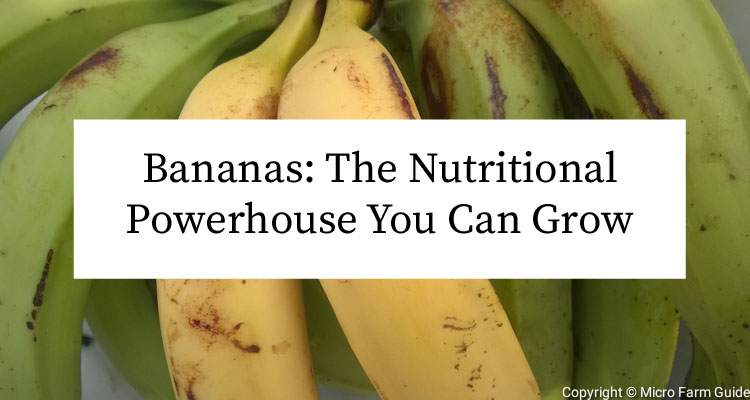Bananas are more than just a tasty fruit. They are iconic symbols of health, wealth, and tropical life.
They are packed with energy and full of nutritional benefits, some of which are fascinating, to say the least.
To date, people use bananas in celebrations, stories, and as slang in everyday speech, showing just how deeply it is integrated into our culture.
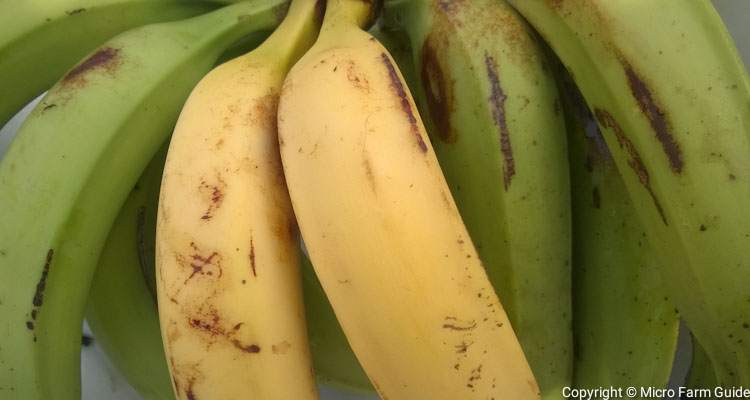
In this article, you’ll learn about the different types of bananas, their incredible nutritional value, and even how you can grow your own banana trees at home.
So, let’s dive into the exciting world of bananas and debunk a common myth along the way!
- What are Bananas?
- Banana Varieties (with Examples)
- Where Do Bananas Come From?
- How To Use Bananas In Your Kitchen
- Do Bananas Make You Gain Weight?
- Nutritional Benefits Of Bananas
- How to Grow Bananas in Your Garden
- Environmental Impact Of Banana Farming
What Are Bananas?
Bananas, or Musa Paradisiaca, are tropical flowering shrubs belonging to the Musaceae family.
As expected, they are found in warm areas, usually under the protection of rainforests.
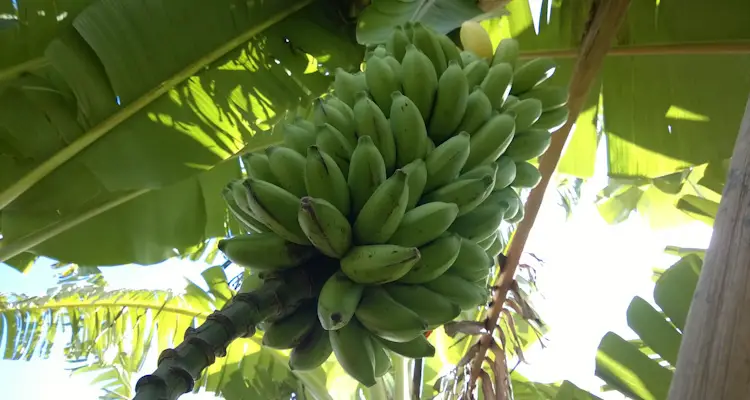
Banana plants are generally tall with large leaves that fan out like a tiny windmill.
They often grow in clusters called stools containing several plants that grew from the main plant.
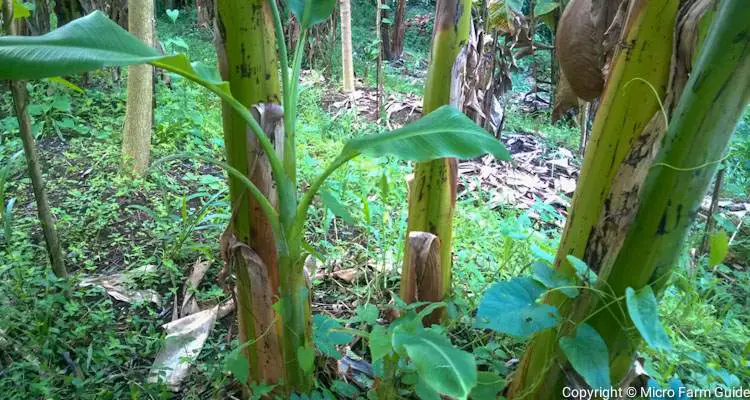
Bananas come in various shapes and sizes and are typically curved, with vibrant yellow skin when ripe.
They’re smooth and can be easily peeled. Inside, you’ll find soft, creamy, and sweet flesh. Yet, they are starchy when green.
Banana Varieties (with Examples)
When you see bananas in a grocery store, you’re probably looking at the most common type: the Cavendish banana, which is sweet and good for snacking.
However, this is only one of several varieties found throughout the world.
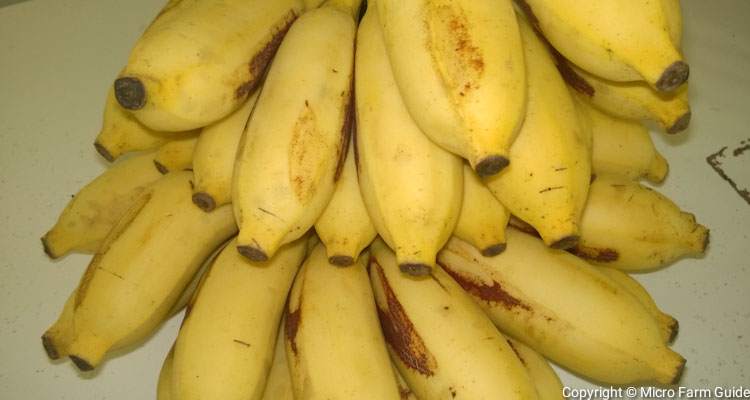
For instance, Bananas are classified into two main categories:
- Bananas are sweet, and you can eat them ripe.
- Plantains are starchy and used for cooking.
Under each of these are several varieties to choose from, such as the “local varieties” found on our island; Rock Fig, Thousand Grains, Blugguh, Greendie, and even one called Gros Michel.
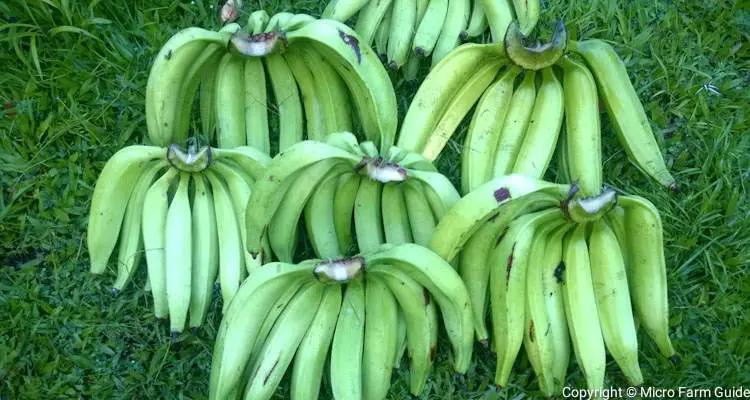
I have several of these “local varieties” planted in my garden, but the real treasure is plantains, due to its market value.
I’ve even heard of Red bananas, but I’ve not gotten a plant yet to add to the collection.
Where Do Bananas Come From?
Bananas originated in Southeast Asia, in the rainforests of Malaysia and Indonesia.
It was spread throughout the world through trade and exploration, with colonialism accelerating their movement to Europe and the Americas.
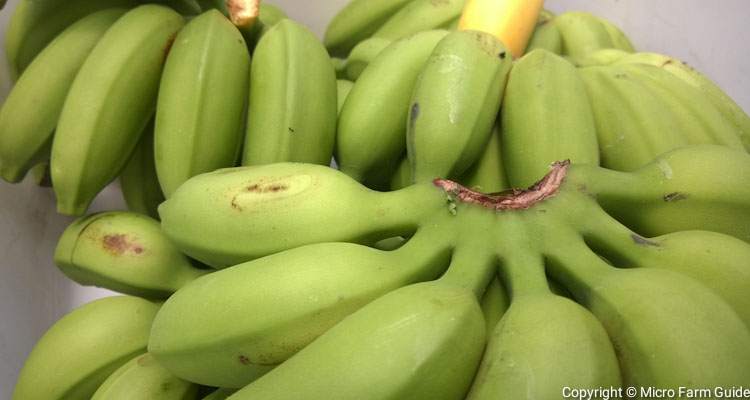
In some instances, the trade of Bananas was also accompanied by cultural practices, rituals, and festivals.
Bananas have even made their way into art, stories, and songs, showing how deeply rooted it is in our culture.
For instance, the descendants of the East Indian community on our island still celebrate an annual festival called Saraca by serving various foods on banana leaves.
Talking about food, let’s take a look at some:
How To Use Bananas In Your Kitchen
Bananas are incredibly versatile in the kitchen. You can eat them ripe or use them to make treats like banana bread, fritas, or smoothies.
On our island, green bananas are called “green figs.” You can steam, fry, or cook green bananas and plantains in soups or salads.
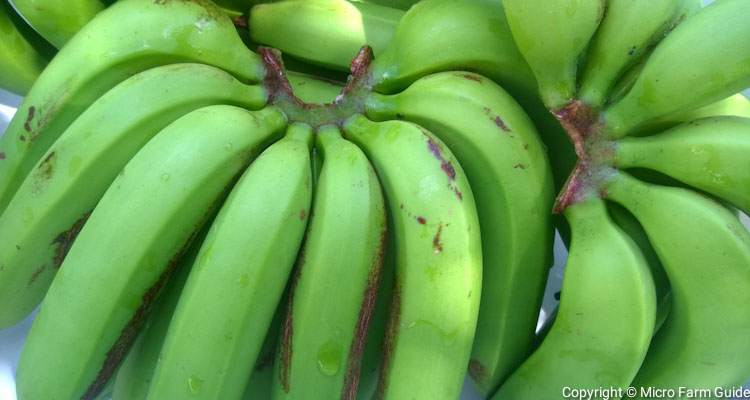
Green bananas can be dried and ground into flour or made into other products.
And what happens if you have too many ripe bananas? You don’t need to throw it away since you can make vinegar at home.
There is also a variety of bananas that do not produce fruit. Still, the core of the plant itself is edible, but that’s a topic for another article.
Do Bananas Make You Gain Weight?
Now, before we go any further, I’d like to clear up a common banana myth.
Some people say that eating bananas will make you gain weight. However, the truth is that eating a banana or two a day will not magically make you get fat.
In fact, as we see in the nutrition information below, bananas are full of vitamins, minerals, and other nutrients that are good for your heart, digestion, and overall energy levels.
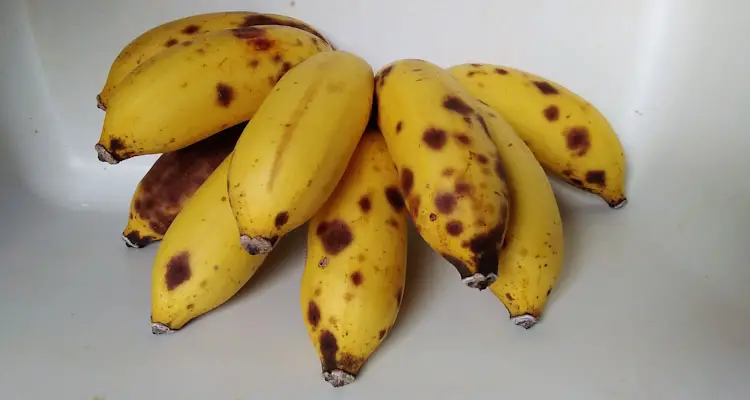
They’re part of a healthy diet when you enjoy them in moderation.
However, I must admit you can feel bloated if you overindulge, often resulting in several trips to the toilet.
Nutritional Benefits Of Bananas
Bananas are loaded with Vitamins, minerals, and other beneficial compounds necessary for a robust and healthy body.
Here is a breakdown of Bananas’ Nutritional Information courtesy of NutritionValue.org:
| Nutrient | Amount Per 7” Fruit (116g) | % Daily Value |
| Calories | 105 | 5.25% |
| Fat | 0.4 g | 1% |
| Sodium | 1.2 mg | 0% |
| Carbohydrate | 27 g | 10% |
| – Fiber | 3.07 g | 11% |
| – Sugar | 14 g | |
| Protein | 1.3 g | 3% |
| Calcium | 5.9 mg | 0% |
| Potassium | 422 mg | 9% |
| Iron | 0.3 mg | 2% |
| Thiamin [Vitamin B1] | 0.037 mg | 3% |
| Riboflavin [Vitamin B2] | 0.086 mg | 7% |
| Niacin [Vitamin B3] | 0.785 mg | 5% |
| Pantothenic Acid [B5] | 0.394 mg | 8% |
| Vitamin B6 | 0.433 mg | 25% |
| Vitamin C [Ascorbic Acid] | 10.3 mg | 11% |
| Magnesium | 31.86 mg | 8% |
| Phosphorus | 25.96 mg | 2% |
How to Grow Bananas in Your Garden
If you live in a warm region and have some extra space in your garden, then here are some simple steps to grow Bananas in your backyard.
1. Choose A Suitable Location
First, select a sunny spot in your garden with well-draining soil. Bananas usually grow in the rainforest, so they can also grow in dappled light, thanks to their broad leaves.
However, they do not do well in cold or freezing temperatures. As a result, you will need to be mindful of your climate as well.
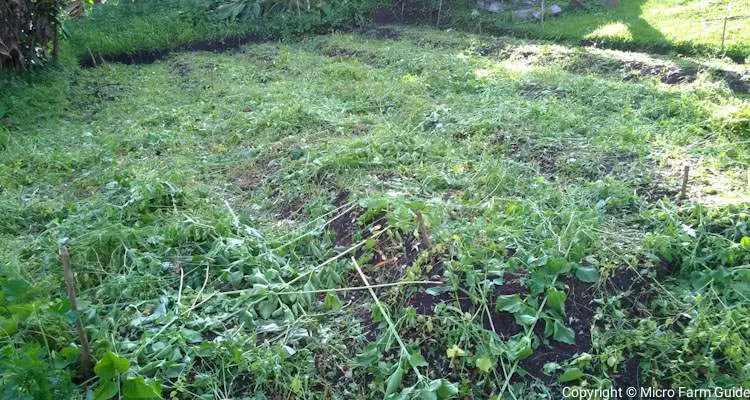
2. Select The Right Variety For Your Area
Buy a healthy banana pup or plant from a nursery. In most cases, these will be in bags and already starting to root, making transplanting easy for a beginner.
Select a variety suitable for your climate and yard space. For example, you can choose a dwarf variety if you have limited space. Remember, regular banana plants can grow well over 10 feet.
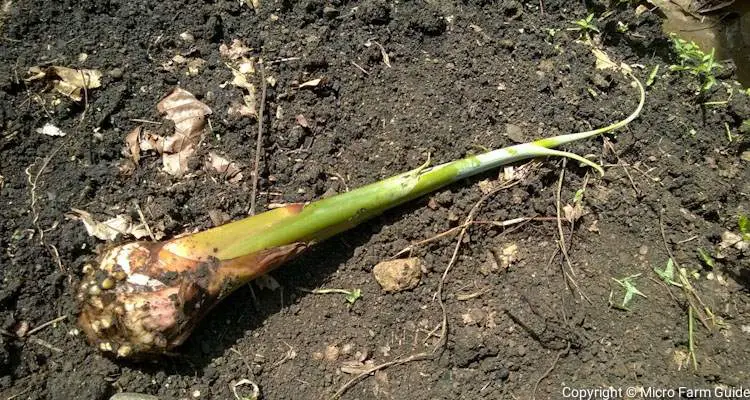
3. Plant Your Bananas Plants
Next, Dig a hole deep enough for the plant, ensuring the top of the roots is level with the soil surface.
Cover the hole with soil and water thoroughly. Space multiple plants at least 10-12 feet apart.
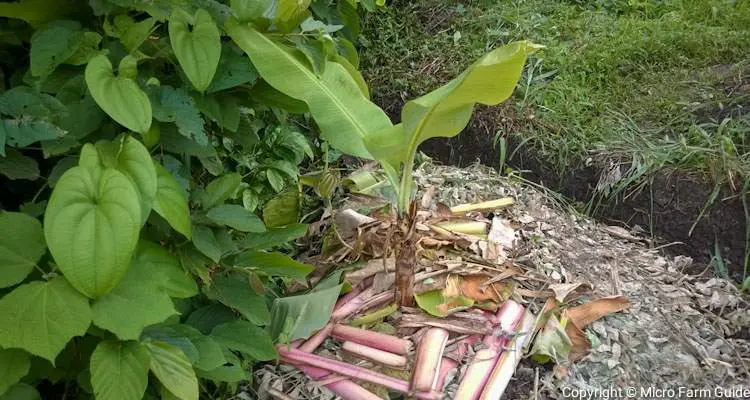
4. Mulch Plants During Dry Spells
Add a layer of organic mulch around the plant to retain moisture and suppress weeds.
5. Water Plants Regularly
Bananas thrive in well-draining, nutrient-rich soil. Keep the soil consistently moist, but avoid waterlogged conditions.
6. Fertilize Plants
Feed your banana plant with a balanced fertilizer, especially one high in potassium.
Generally, I create a liquid fertilizer using banana plants, fruit, flower and fruit.. Still, you can also purchase one meant for fruiting plants and apply it based on the instructions.
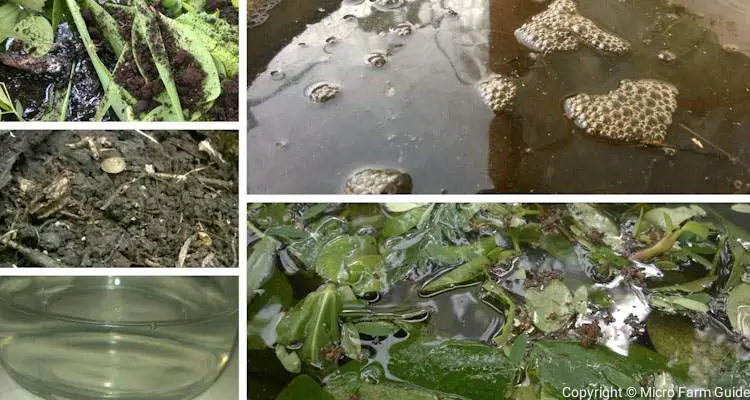
7. Remove Dry And Damaged Leaves
Remove dead or dry leaves regularly to encourage the free flow of air and healthy growth.
Place the leaves around the base of the plants as mulch.
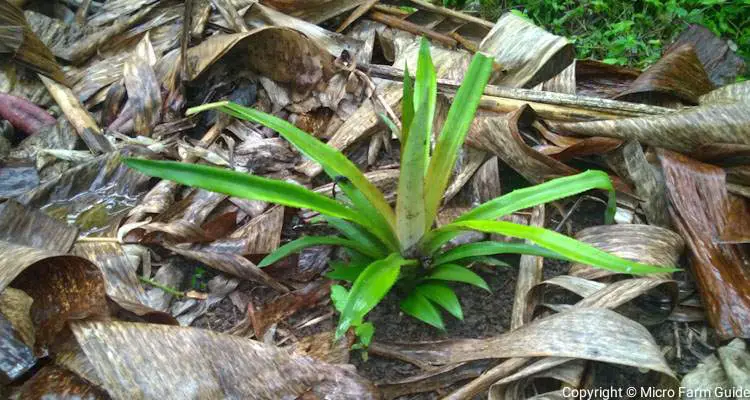
8. Monitor For Signs Of Stress, Pest, And Disease
If you notice abnormal yellowing of leaves or soft, discolored stems, don’t hesitate to get in touch with your local Agricultural extension office.
They will, at the very least, rule out the presence of contagious viral or fungal disease in your area.
9. Harvest Bananas When Ready
Bananas can take about 9 months to produce fruit and several months afterward to ripen.
You do not have to wait until they are entirely yellow to harvest. Instead, pick bananas based on your needs. Remember, you can cook green bananas.
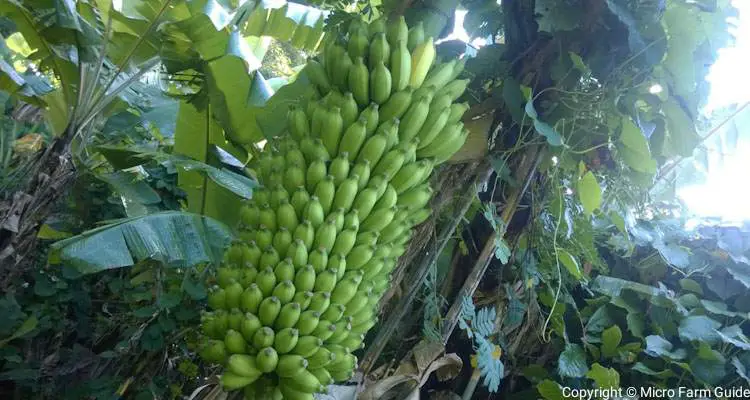
Environmental Impact Of Banana Farming
While we love bananas, the way we farm them has resulted in significant damage to the environment.
Rainforests have been wiped out, and thousands of acres have been sprayed with toxic pesticides, leading to the death of birds, fish, beneficial insects, and other wildlife in the area.
But thankfully. there are now ways to farm bananas more sustainably, and even reverse some of the negative effects.
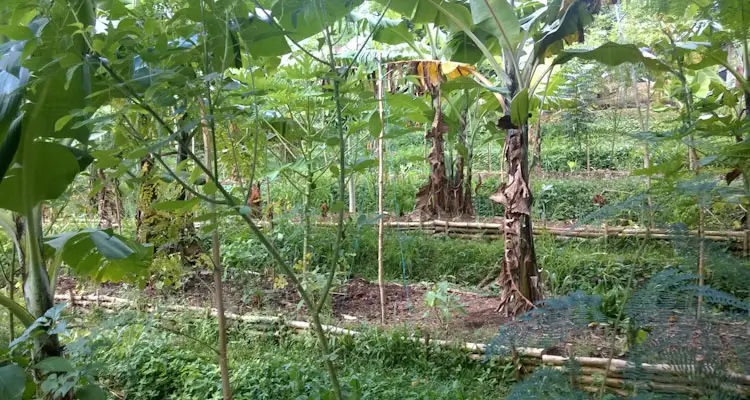
Some farmers go organic, relying on farming practices such as Syntropic Agriculture, which doesn’t use harmful chemicals.
Others follow fair trade practices to ensure workers are treated well.
Despite these changes, the banana industry now faces challenges like Panama disease, which has been shown to wipe out plantations in a short time.
Final Thoughts
Thank you for joining us on this little banana journey!
To sum it up, bananas are not just delicious. They’re packed with good stuff like potassium, vitamins, and fiber.
They’ve been a part of our cultures and history for centuries, and they’re a fantastic addition to your diet.
Now, we encourage you to explore the world of bananas further. Try new recipes, grow your banana tree, and share some of the harvest with your friends.
If you’re eager to learn more plant-related knowledge, head to our Plant Guide page. Happy banana adventures!
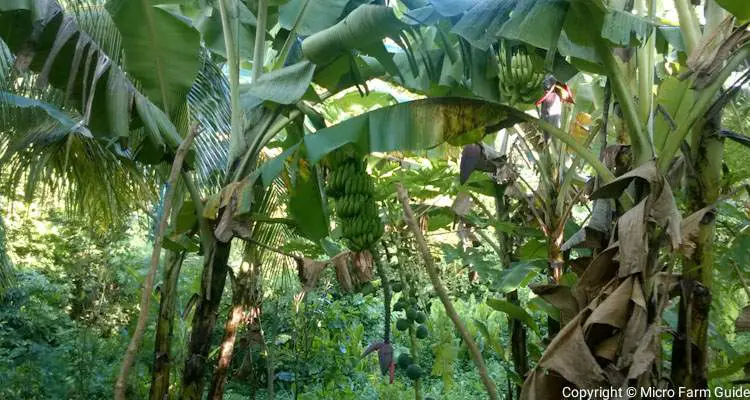
Related Questions
1. What are the benefits of bananas?
Bananas are an easy-to-carry natural source of quick energy and provide essential nutrients such as vitamins, minerals, and fiber, all of which assist with healthy bodily functions.
2. Are bananas OK to eat every day?
Yes, you can eat bananas daily, provided you do so in moderation and as part of a balanced diet. It is a healthy snack full of essential nutrients like potassium and fiber.
3. Do bananas raise blood sugar quickly?
Yes, very ripe bananas can cause blood sugar to rise quickly due to their high concentration of simple sugar. However, this differs from green and half-ripe bananas, whose sugars are primarily starch.
References
Harvard School Of Public Health. Bananas. hsph.harvard.edu. Accessed November 2023
Utah State University. Fruit and Vegetable Guide Series: Bananas. extension.usu.edu. Accessed November 2023
Nutrition Value. Bananas, Raw – Nutrition Facts Chart. nutritionvalue.org. Accessed November 2023
Britannica Online. Banana. britannica.com. Accessed November 2023
AgriLife Extension. Home Fruit Production – Bananas. hortipm.tamu.edu. Accessed November 2023

